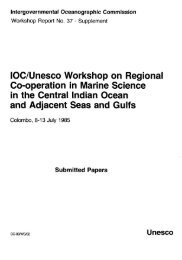Manual on sea level measurement and ... - unesdoc - Unesco
Manual on sea level measurement and ... - unesdoc - Unesco
Manual on sea level measurement and ... - unesdoc - Unesco
- No tags were found...
Create successful ePaper yourself
Turn your PDF publications into a flip-book with our unique Google optimized e-Paper software.
Sea Level Measurement <strong>and</strong> Interpretati<strong>on</strong>waves: FMCW). The OTT Kalesto, Miros <strong>and</strong> Radac instrumentsuse this method. The VEGA <strong>and</strong> SEBA systems usepulsed transmissi<strong>on</strong>s <strong>and</strong> time-of-flight <strong>measurement</strong>.All these gauges have underg<strong>on</strong>e initial tests <strong>and</strong> intercomparis<strong>on</strong>sby various agencies in different countries.Details of these tests can be found in IOC WorkshopReport No 193. Details of the individual instruments canbe found <strong>on</strong> the websites shown below.In principle, the instruments are self calibrating,as far as a datum value is c<strong>on</strong>cerned. However, toprovide c<strong>on</strong>fidence that the datum remains c<strong>on</strong>stantover l<strong>on</strong>g time periods, alternative means are beinginvestigated. These take the form of a reflector thatcan be placed in the radar beam at appropriateintervals. The reflector is placed at a known distancebelow the c<strong>on</strong>tact point of the installati<strong>on</strong> for a shortperiod. Over a period of a year or more the datumvalue can be verified <strong>and</strong> used to adjust the <strong>measurement</strong>s,if necessary.Initial indicati<strong>on</strong>s that these instruments can provideacceptable <strong>measurement</strong>s for the purposes ofGLOSS are promising. As with all tide gauges, practicalc<strong>on</strong>siderati<strong>on</strong>s related to a particular applicati<strong>on</strong>often dominate other c<strong>on</strong>siderati<strong>on</strong>s. For example,they have very limited applicati<strong>on</strong> in polar regi<strong>on</strong>s.They have not yet been used in extremely hostileenvir<strong>on</strong>ments, for example <strong>on</strong> remote isl<strong>and</strong>s, whereextreme waves may overtop the gauge by severalmetres. However, for a normal applicati<strong>on</strong> in which astilling well or bubbler gauge is presently in use, theyappear to operate satisfactorily.3.6 Summary of the Merits of DifferentTechnologiesIn this secti<strong>on</strong>, we summarize the relative meritsof different tide gauge technologies for scientificre<strong>sea</strong>rch, operati<strong>on</strong>al oceanography <strong>and</strong> for localizedpractical purposes, such as harbour operati<strong>on</strong>s.The GLOSS programme has scientific re<strong>sea</strong>rch asits rais<strong>on</strong> d’être, although it is intended that thedevelopment of the GLOSS networks should serve toimprove st<strong>and</strong>ards overall (see IOC, 1997). We canuse the designati<strong>on</strong> ‘GLOSS’ to indicate the mostdem<strong>and</strong>ing requirement of scientific-quality performanceof a gauge (Appendix I).There are also <strong>sea</strong> <strong>level</strong> requirements from operati<strong>on</strong>alusers of oceanographic data in such topicsas marine infrastructure (e.g. offshore industry,transport, coastal recreati<strong>on</strong>) <strong>and</strong> coastal defences(e.g. flood protecti<strong>on</strong> from surges, <strong>and</strong> studies ofcoastal erosi<strong>on</strong> or <strong>sea</strong> <strong>level</strong> rise impacts). Many ofthese applicati<strong>on</strong>s overlap GLOSS interests, thestudy of secular changes in <strong>sea</strong> <strong>level</strong> being an obviousexample. However, the particular applicati<strong>on</strong>swill vary from country to country. Therefore, suchgauges will be capable of deployment for extendedperiods, but perhaps not to the same high st<strong>and</strong>ardsas those intended for GLOSS, <strong>and</strong> will be affordablefor use in larger numbers than for GLOSS, especiallyby developing countries.Finally, there will be applicati<strong>on</strong>s which require acheap instrument capable of showing the state ofthe tide at any moment but certainly not accurateenough for GLOSS.Table 3.1 presents a summary of the main c<strong>on</strong>clusi<strong>on</strong>s<strong>on</strong> the relative merits of each gauge technologybased <strong>on</strong> the previous secti<strong>on</strong>s of this <str<strong>on</strong>g>Manual</str<strong>on</strong>g>.The Table also includes an estimate of the likely costof a basic system with gauge, data transmissi<strong>on</strong> (e.g.modem) <strong>and</strong> meteorological package, although thisis an extremely difficult item to quote given the largenumber of manufacturers, m<strong>on</strong>etary exchange ratesetc. For example, the cost of a pressure transducerwill vary by a factor of 3 depending <strong>on</strong> the quality.With these reservati<strong>on</strong>s in mind, Cost B<strong>and</strong> 3has been set as the highest cost, which might be12,000–20,000 US$ (at the time of writing <strong>and</strong>within a large b<strong>and</strong>, say 30%); B<strong>and</strong> 2 might be8,000–12,000 US$; <strong>and</strong> B<strong>and</strong> 1, 5,000–8,000 US$.However, in our experience, the real costs of any tidegauge stati<strong>on</strong> are those of installati<strong>on</strong> (e.g. some kindof engineering support will be needed for installati<strong>on</strong>of a stilling well, acoustic sounding tube gauge, or‘B’ gauge; diver support will be needed for pressuregauge installati<strong>on</strong>s etc.), <strong>on</strong>going maintenance <strong>and</strong>data analysis (with implicati<strong>on</strong>s for staff resources).Any<strong>on</strong>e planning a gauge installati<strong>on</strong> has, therefore,to take into account all the local costs as well as theup-fr<strong>on</strong>t costs of gauge hardware. Agencies participatingin GLOSS which require the input of expertisemay wish to explore the possibilities of collaborati<strong>on</strong>with other GLOSS participants.Our recommendati<strong>on</strong>s are:• If <strong>on</strong>e is planning a new GLOSS tide gauge stati<strong>on</strong>in a mid- or low-latitude locati<strong>on</strong>, <strong>on</strong>e should probablyopt for:- an acoustic gauge with sounding tube or- a radar tide gauge or- a ‘B’ pressure gaugeIf low tidal range or other factors preclude the use ofa ‘B’ gauge, then a single transducer pressure gauge,a bubbler pressure gauge or a pressure transducer ina stilling well would be opti<strong>on</strong>s. In additi<strong>on</strong>, in mostcases, the main tide gauge should be accompaniedby a pressure sensor installed in the <strong>sea</strong> <strong>and</strong> capableIOC <str<strong>on</strong>g>Manual</str<strong>on</strong>g>s <strong>and</strong> Guides No 14 vol IV21
















